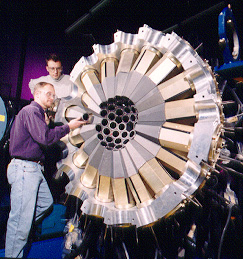 Gammasphere
Gammasphere
Gammasphere is the world's most powerful spectrometer for nuclear structure research and is especially good at collecting gamma ray data following the fusion of heavy ions.
Gammasphere was built by a consortium of scientists from national laboratories and many universities. The project was coordinated by scientists at Lawrence Berkeley National Laboratory, where the device was first assembled. It consists of 110 high-purity germanium detectors, each about the size of a coffee cup, in a spherical arrangement.
Beams of ions from the Argonne Tandem-Linac Accelerator System, or ATLAS, are directed at a target (usually a thin metal film). Nuclei from the beam fuse with those in the target, producing highly excited, much heavier nuclei. Gammasphere detects gamma rays — high-energy light particles — emitted from the excited nuclei as they spin and cool. Gammasphere first moved from Lawrence Berkeley National Laboratory to Argonne in the fall of 1997 and returned to Argonne again in 2003. At Argonne, Gammasphere research has centered on studying nuclei far from stability.
Video Feature |
||||||
|
![[Argonne Logo]](/images/argonne_header_logo.jpg)
![[DOE Logo]](/images/header_doe.gif)